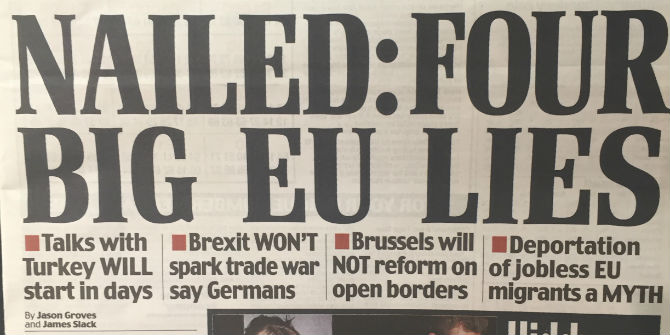 Britain’s media is highly partisan, and this was more apparent than ever in the run-up to the EU referendum. In this extract from a report on media coverage of the campaign, Martin Moore (left) and Gordon Ramsay explain how the Leave campaign styled Remain’s warnings about the effects of Brexit as ‘Project Fear’, accusing ‘experts’ arguing for the status quo of self-interest and a lack of patriotism. Leave then went on to make immigration the key issue, with the Express, Mail and Telegraph urging voters to ‘take back control’ of Britain’s borders.
Britain’s media is highly partisan, and this was more apparent than ever in the run-up to the EU referendum. In this extract from a report on media coverage of the campaign, Martin Moore (left) and Gordon Ramsay explain how the Leave campaign styled Remain’s warnings about the effects of Brexit as ‘Project Fear’, accusing ‘experts’ arguing for the status quo of self-interest and a lack of patriotism. Leave then went on to make immigration the key issue, with the Express, Mail and Telegraph urging voters to ‘take back control’ of Britain’s borders.
The campaign leading up to the vote to remain or leave the EU on 23 June 2016 was the UK’s most divisive, hostile, negative and fear-provoking of the 21st century. This was partly due to the rhetoric and approaches of the campaigns themselves, but was encouraged and enflamed by a highly partisan national media.
Remain set the campaign agenda early on – focusing on the potential damaging economic consequences of Brexit, seeking and publicising endorsements of staying in the EU from domestic and international politicians and institutions. Leave, however, successfully undermined the economic warnings of Remain by questioning the campaign leaders’ honesty, their expertise, their motivation, and by presenting the whole economic narrative as a cynical strategy to frighten people into voting for the status quo.

As a consequence, Remain lost many of the benefits normally associated with agenda setting. Indeed, by the latter part of the referendum campaign Leave had managed to turn Remain’s ability to set the agenda into a liability, by characterising the authoritative figures and institutions that supported Remain as self-interested, dishonest and unpatriotic.
As the campaign wore on, Leave campaign leaders and Leave-supporting news outlets began to wrest the agenda away from economic issues towards immigration. Coverage of immigration tripled over the course of the 10-week campaign and, after purdah ended, was increasingly linked to economic issues (for example: ‘Soaring cost of teaching migrant children’; ‘Migrants cost Britain £17bn a year’). During the final four weeks almost half of all referendum-related articles that referred to the economy also referred to immigration, as compared to just over a quarter during the first six weeks.
Immigration was sometimes discussed in the context of sovereignty, but more often coverage was direct – in other words referring to foreign people coming to, or living in, the UK. It was framed, primarily by Leave campaign leaders and the Leave-supporting press, in almost entirely negative terms. Iain Duncan Smith, Priti Patel, Michael Gove, Boris Johnson, and Nigel Farage all made frequent negative claims about immigration and about the damaging effect of migrants on the UK. These comments, and other negative references to migrants, were covered copiously and prominently in the press. There were more leading front pages about immigration during the campaign than about the economy. Six in 10 of these immigration front pages were published by three newspapers, the Daily Express, the Daily Mail, and the Daily Telegraph. According to Leave campaigners and these Leave-supporting news outlets, immigration and immigrants were to blame for many of the UK’s political, economic and social problems.
Remain, rather than seeking to argue for the benefits of immigration to the UK or the positive case for free movement of people within Europe, chose first to play down the issue, then to emphasise their proposals to reduce migrant numbers. Eventually campaign leaders turned to criticism of Leave’s anti-migrant rhetoric.
Leave campaigners and partisan news outlets strongly protested against accusations that their focus on immigration was prejudiced or intolerant. Yet, based on most definitions, it is hard not to find their claims and coverage discriminatory. Out of 111 articles that expressed a view about Turks, for example, 98% (109) were negative. Out of 90 articles that expressed a view about Albanians, 100% were negative. Three metaphors were dominant in the coverage of migrants: migrants as water (‘floodgates’, ‘waves’), as animals or insects (‘flocking’, ‘swarming’) or as an invading force.
Sovereignty was not, as has been claimed, a more important issue during the campaign than immigration. Sovereignty was a secondary issue, discussed in the context of primary issues like the economy, immigration and healthcare. It was a way for people to talk about the political issues they cared about, and about gaining greater power over those issues, however they were defined. Hence why almost half the references to sovereignty also included references to the ambiguous Vote Leave slogan ‘Taking back control’.
Other political issues were dwarfed by coverage of the economy and immigration. The implications of Brexit for each of the UK’s devolved nations, for the environment, for foreign policy and defence, or for 165 education were all reported and editorialised far less than these two primary political issues.
Of course, national media coverage represents only one factor influencing people’s decision to vote in the 2016 EU Referendum. Many people would have made up their mind before the campaign began. Others were undoubtedly guided by the views of their family, friends and colleagues. Others were swayed by digital communications sent directly to their email inbox or to their social media feed.
Direct digital communication was, according to Vote Leave’s director Dominic Cummings, where the Leave campaign devoted most of its resources. Vote Leave sent, Cummings wrote, ‘nearly a billion targeted digital adverts’ and spent approximately 98% of their money on digital campaigning. The Vote Leave director believed that data and digital were so important to the Leave campaign that he advised future campaigners to ‘hire physicists, not communications people from normal companies’. Digital communication was similarly important to Stronger In, who employed Tom Edmonds, joint director of the Conservatives’ 2015 digital election campaign, and Jim Messina, who was campaign manager for Barack Obama in 2012.
Yet mainstream media, including broadcast outlets, still played at least three critical roles: directly influencing the public, indirectly influencing the public, and influencing the campaigns themselves. In terms of direct influence, mainstream media still reached almost the entire UK population on a regular basis. During the campaign itself, most national print circulations and online readership rose. As previous research in this area has shown, it is likely that mainstream media generated much of the news that was liked and shared on social networks – indirectly influencing people through sharing and via online discussion. Moreover, mainstream media strongly influenced politicians and campaigners themselves, who devoted considerable time and energy to trying to shape the press agenda, or to attack opponents and defend their previous statements.
The importance of national media to politicians and campaigners comes across clearly in the various accounts of the campaign written in the months following the vote. Dominic Cummings writes about politicians’ obsession with appearing on television. Craig Oliver’s published diary focuses on his daily battles to win primacy in the press and on screen. All Out War, Tim Shipman’s detailed account of the campaign, records the constant efforts of both the Remain and Leave camps to set the television and press agenda.
The rancorous, bitter way in which the referendum campaign was fought was both reflected in, and enhanced by, the media coverage. The majority of media organisations that could take sides – excluding public service broadcasters bound by regulations ensuring impartiality – did so, often uncompromisingly. Their partisanship was then played out in much of their coverage – both in their selection and framing of news and in their editorials, leader columns and their choice of front-page stories. Those voices urging calm or seeking to find some consensus between the sides were rare, except in the aftermath of the murder of Labour MP Jo Cox a week before the referendum vote.
Eventually the campaign became framed as us-versus-them, proEstablishment versus anti-Establishment, pro-immigration versus anti-immigration, nationalist versus internationalist. Rather than seek to provide a public space in which each side could fairly challenge the other, many news outlets encouraged and stoked the partisanship.
Almost a year after the referendum vote, few of the more dire economic predictions of the Remain camp had come to pass. House prices had not dropped by 18% as George Osborne predicted; Britain had not fallen into a year-long recession; there was not an emergency Brexit budget. The Bank of England, the OECD, the IMF, and the European Commission all revised their economic forecasts for the UK upwards, and said they were mistaken about the short-term impact of Brexit. At the same time, prominent spokespeople in favour of leaving distanced themselves from some of the campaign’s most striking promises, such as spending £350 million on the NHS, and from its claims about the falling rate of immigration to the UK after Brexit.
Yet much of the acrimony, partiality and suspicions of dishonesty that characterised the campaign has remained. The consequences of the EU referendum campaign are still being played out, and will continue to be throughout the period that Britain negotiates its departure from the EU and beyond. The implications of a divisive, antagonistic and hyper-partisan campaign – by the campaigners themselves as much as by many national media outlets – is likely to shape British politics for the foreseeable future.
This post represents the views of the authors and not those of the Brexit blog, nor the LSE. It is an extract from a report by King’s College London’s Centre for the Study of Media, Communication and Power, UK Media Coverage of the 2016 EU Referendum Campaign, where full references can be found.
Martin Moore is director of the Centre for the Study of Media, Communication and Power, and a Senior Research Fellow in the Policy Institute at King’s College London.
Gordon Ramsay is a Research Fellow and Deputy Director of the Centre for the Study of Media, Communication and Power at King’s College London.







4 Comments